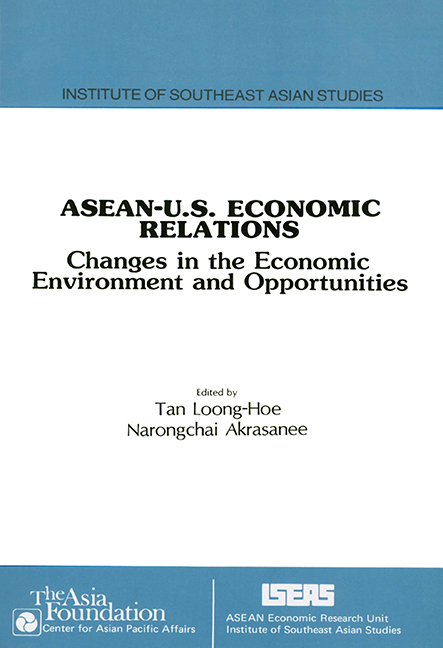Book contents
- Frontmatter
- Contents
- List of Tables
- List of Figures
- Foreword
- Changes in the ASEAN-U.S. Economic Environment and Opportunities: An Introductory Overview
- PART I ECONOMIC TRENDS
- 1 Economic Trends in the United States and Their Implications for ASEAN
- 2 Increasing Protectionism and Its Implications for ASEAN-U.S. Economic Relations
- PART II STRUCTURAL ADJUSTMENTS
- PART III TRADE IN SERVICES
- PART IV ROLE OF PRIVATE SECTOR
- THE EDITORS
2 - Increasing Protectionism and Its Implications for ASEAN-U.S. Economic Relations
from PART I - ECONOMIC TRENDS
Published online by Cambridge University Press: 21 October 2015
- Frontmatter
- Contents
- List of Tables
- List of Figures
- Foreword
- Changes in the ASEAN-U.S. Economic Environment and Opportunities: An Introductory Overview
- PART I ECONOMIC TRENDS
- 1 Economic Trends in the United States and Their Implications for ASEAN
- 2 Increasing Protectionism and Its Implications for ASEAN-U.S. Economic Relations
- PART II STRUCTURAL ADJUSTMENTS
- PART III TRADE IN SERVICES
- PART IV ROLE OF PRIVATE SECTOR
- THE EDITORS
Summary
An often stated and widely held perception is that protectionism has been increasing. As at the recent Bali Meeting of ASEAN Foreign Ministers, this generally refers to increased protectionism by developed countries against the exports of developing countries. There is seldom any precise definition of what is meant by protectionism or any empirical evidence presented to support the contention that protectionism has increased. Certainly, the growth in exports from developing countries to industrial countries in general has slowed (or, in some instances, become negative) as has the growth of exports from ASEAN countries to the United States. However, this slow-down of trade could result from factors other than protection. For example, in the specific case of the United States and ASEAN, it could result from reduced U.S. growth, changed U.S. tastes, greater competition for ASEAN from other sources of exports to the United States, and ASEAN domestic policies adversely affecting ASEAN exports. Together, these factors could make the “bite” of protectionism seem greater regardless of whether protectionism has been increasing.
Why Might Protectionism Have Increased?
Barriers to international trade, especially in the form of tariffs, have been reduced significantly through concerted international policies over the past thirty years, particularly in industrial countries. The past decade, however, has witnessed increasing concern that protectionism is emerging again as a potential force, powerful enough to affect perceptively the growth of world trade. Apprehension about increasing application of non-tariff barriers, which are typically more discriminatory and less transparent than tariffs, is particularly widespread. As a preface to examining the record of increasing protectionism in the next section, this section considers why protectionism might be increasing in the United States and the ASEAN countries.
Before turning to consider circumstances bearing on protectionism in the United States and the ASEAN countries, it should be noted briefly that some important hypotheses have been advanced to explain “long” cycles in international trade relations.
- Type
- Chapter
- Information
- ASEAN-U.S. Economic RelationsChanges in the Economic Environment and Opportunities, pp. 24 - 64Publisher: ISEAS–Yusof Ishak InstitutePrint publication year: 1988

